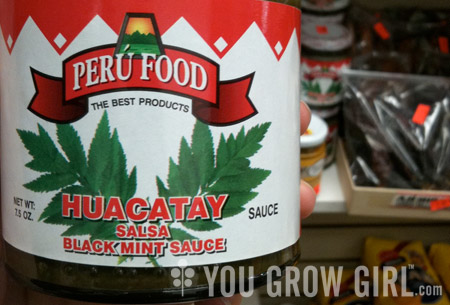
I have so much to tell you about the Ecuadorian food store in my neighbourhood that it was difficult working out where to begin. I’ve travelled in Southern Mexico and I’ve perused many Latin American food stores, yet this store was a treasure trove of exciting food stuffs I had never seen before, primarily from Peru, Ecuador and Columbia. The packaging was delightful, too. But that’s a post in itself.
First up is huacatay, a dark sauce in a jar that had me perplexed. The label identified the main ingredient as “black mint”, but the illustration on the front looked nothing like the black peppermint I am familiar with. If I had to take a guess, I’d say it was a marigold, but even though I eat marigolds (particularly the gem series), I do so in small quantities and could not imagine devoting it to a sauce. Because that seemed illogical, I chalked the illustration up to the sort of packaging that just has any old plant stuck into the design.
Back at home, a quick search online brought up the answer: it is a marigold! According to the Richters Herbs catalogue, black mint or Mexican marigold (Tagetes minuta) is used primarily for its leaves. They are used dried and fresh to flavour soups and meats. It is also planted amongst bindweed (Convolvulus arvensis) infestations as the roots secrete a chemical compound that functions as an herbicide against some weeds. Like some other marigolds, it is also an effective insecticide and nematicide (nematode killer). This post can tell you more.
Sounds like a miracle plant, doesn’t it? How is it that I had not heard of it before now? I’ve grown a lot of different marigold species and had naively assumed that I had the whole genus covered off.
Unfortunately, I did not purchase a jar but you can bet that I will be going back as soon as I can to pick one up. Even if the taste isn’t great, I am determined to grow it in the garden this year. We have a bindweed problem in the back along the fence that was difficult to control last summer. The roots are actually in my neighbour’s soil with the plants coming through the fence to choke out my tomatoes, but perhaps I can convince them to grow it, too.
I’ll report back on the taste as soon as I can.
my curiosity is always stimulated when food is involved…
Hi Gayla, I have grown Mexican Marigold many times and love its scent and its height. Quite tall 2-3 feet. However, it is a long season Marigold, having so much more sun in its native climate and so I have never been able to save any seeds. One particularly long summer here in Toronto I really thought “This is the year” but shortly after forming little flower buds a frost hit and hopes were dashed. Can’t wait to see how it does for you.
I just commented to someone else below about this… There is another edible marigold that is also called Mexican Marigold. Different species…. Tagetes lucida. Do you mean that one or this? This one looks more like a ferny marigold where-as Tagetes lucida looks more like tarragon… but the flowers are very marigold. I’ve grown it from seed but have never managed to get flowers either. I’ve only seen the flowers in southern climates.
Love exploring, trying new foods and raising botanical inquiries at the local international grocer. Have you ever grown seeds from the spice section? Sometimes it is a cheaper way to buy seed. Fun stuff. Thanks for sharing.
Neato! I love exploring ethnic grocers. I don’t think I’ve been to a Colombian one before! What is the name of this one?
I’ve grown Mexican mint marigold for many years down here in Houston, TX. It’s touted as a substitute for tarragon, which doesn’t do very well in the extremely hot summers here. It is actually practically perennial in my garden- I chop it down to the ground when a frost withers it, and after our mild winter it fluffs right back out for spring.
This is one of those examples where the common name really confuses things. The plant I believe you’re referring to is Tagetes lucida… also called Mexican Marigold. You’re right, it tastes a lot like tarragon. I grow it here as well, and like this plant, is a perennial and is tough to get to flower in our shorter season. It has thin leaves and actually looks quite a bit like tarragon, while this one has fernier leaves and looks really similar to another edible marigold that I’ve grown called ‘Lemon Mint’ (Tagetes lemmonii).
I also have a huge bindweed problem that runs right along the side of the house – pulling out the roots has proven fruitless to controlling the problem. I’ll have to get my hands on some of those seeds, I’d love to have another plant tackle them for me.
do you have any concerns regarding the use of pesticides in Mexico, central and south America that have been banned in the U.S. e.g. DDT? I understand that it is still widely used in those countries.
Sure, but I’m talking about buying one jar in order to try a taste. Terrible pesticides are still used in the US as well.
Hi there, I like your site–where in the north parts of North America are you gardening? I am in the Toronto area and looking for sites and blogs in this area.
I am in Toronto. Cheers!
Hi there,
What a cool sounding plant! Thanks for the info. I was just wondering – what is the name and location of this store? I live in Toronto and my partner is from Ecuador so we would obviously love to visit the store!
Thanks!